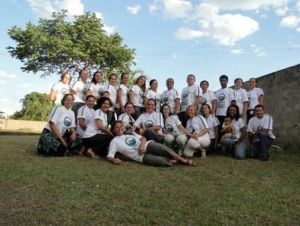
Analysis of Education in the target area was based on data collected by the variable Education at the UNDP on the occasion of the Human Development Index in 1991 and 2000 and analysis of tabular data Sample Education systematized during the 2010 census. These variables were compared with the values obtained for Brazil and states that make up the target area studied.
 Regarding the sample of census data on education in 2010, the public network is the means by which 81,15% of the universe of Brazilian students studying. Municipalities in the target area it is repeated, but with much higher stakes, with all counties above the national average reported. This happens in Barreiras do Piauí (100% of students) in Lagoa do Tocantins, Lizarda, Novo Acordo, Rio Sono and Santa Tereza do Tocantins, in Tocantins, where over 99% of students are allocated to public schools.
Regarding the sample of census data on education in 2010, the public network is the means by which 81,15% of the universe of Brazilian students studying. Municipalities in the target area it is repeated, but with much higher stakes, with all counties above the national average reported. This happens in Barreiras do Piauí (100% of students) in Lagoa do Tocantins, Lizarda, Novo Acordo, Rio Sono and Santa Tereza do Tocantins, in Tocantins, where over 99% of students are allocated to public schools.
Regarding the educational level of the São Gonçalo Gurguéia (PI) and Rio da Conceição (TO) lead the percentage of children in nurseries, 6,13% and 5,14%, respectively, in pre-school or class literacy is the case of São Gonçalo Gurguéia , Corrente and Barreiras do Piauí , Piauí all with the highest percentages in the sequence of 26,51%, 19,01% and 14,75%, some well above the national average of 11,57 %.
In Adult Literacy, Tocantins leads the ranking with the participation of the municipalities of Novo Acordo (4,97% of students), Lagoa do Tocantins (4,05%) and Santa Tereza do Tocantins (3,35%). In elementary school the national average is 63,45%, while the municipalities are all considered above average. Fact contrary happens in high school, where all municipalities are below the national average of 15,55%. Highlights for Lizarda, Mateiros, Lagoa do Tocantins, Santa Tereza do Tocantins and Rio Sono, all in Tocantins, with almost 90% of students in elementary school.Lizarda particularly poorly in relation to the number of students enrolled in high school, with insignificant 0,2%. Insofar as the series progresses, the data show more timid.
In pre-university course we have only six municipalities with data (Almas, Lizarda, São Félix do Tocantins, in Tocantins, Alto Parnaíba in Maranhão, Corrente and Santa Filomena in Piauí) and all below 1%of the universe of students. Replicating the already noted in regard to high school students graduate in the region are well below the national average (5,36% of students). Some attention may be given to the municipalities of Barreiras, Corrente and Gilbués (PI) with respect to graduate school, but everyone in the order of 2,5%, less than half the national average. Masters and PhD students are lacking in the consolidated data, confirming the inefficiency of the series in advance of the study area.
It also appears that in municipalities that have compiled data for graduates of the inhabitants strong predilection for the courses in the area of Health and Welfare (average 24,25% of people with degrees in the municipalities of the target area), Social Science, administration and law (20,11%) and education (16,66%). This finding reprises national preference, although there is a tie in the national data in the field of Education in Arts, humanities and letters (11,20%).Regarding academic areas with the highest percentage of graduates in education have the Corrente municipalities (29,98%) and Gilbués (35,37%) in Piauí, in social sciences, business and law there is Almas (29,18% ) and Rio da Conceição (100%), both in Tocantins, Piauí and Barreiras (52,97%) in Piauí, in the areas of science, mathematics and computer stands alone Ponte Alta do Tocantins (27,70%) in Tocantins. Almas in Tocantins and Alto Parnaíba in Maranhão lead the ranking of the highest percentages of graduates in engineering, production and construction, respectively 26,31% and 22,91% in the area of agriculture and veterinary Mateiros (TO) leads with 52,31% of graduates and Barreiras do Piauí (PI) with 47,03%; Rio do Sono and Lizarda have all of its graduates in health and social well-being and ill-specified training area there is significant presence in the municipality of São Felix do Tocantins, Tocantins, with 38,92%. The Services area has no data for any of the municipalities compiled.
Although there is a somewhat negative perception of the data previously reported, the IDH data encourage us with the notion of improvement in the indicator time education. From 1991 to 2000, all municipalities had increases in educational, some quite significant, others less so. The highest values of IDH-Education In 2000, all above the national average (0.781) and the respective state averages, are the municipalities of Santa Tereza do Tocantins, Novo Acordo and Rio da Conceição of the State of Tocantins, with values of IDH-education respective 0.842, 0.819 and 0.801. In turn, those with lower IDH-Education in 2000 are the Mateiros in the municipalities of Tocantins (0.63) Santa Filomena (0.678) and the São Gonçalo Gurguéia (0.713), both in Piauí.